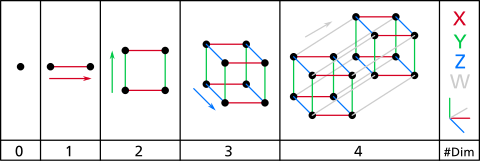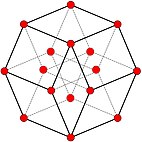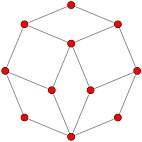Tesseract
| Tesseract 8-cell (4-cube) | |
|---|---|
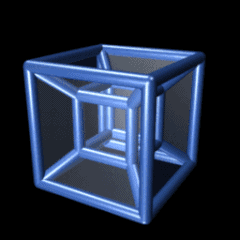 | |
| Type | Convex regular 4-polytope |
| Schläfli symbol | {4,3,3} t0,3{4,3,2} or {4,3}×{ } t0,2{4,2,4} or {4}×{4} t0,2,3{4,2,2} or {4}×{ }×{ } t0,1,2,3{2,2,2} or { }×{ }×{ }×{ } |
| Coxeter diagram | |
| Cells | 8{4,3} |
| Faces | 24{4} |
| Edges | 32 |
| Vertices | 16 |
| Vertex figure |  Tetrahedron |
| Petrie polygon | octagon |
| Coxeter group | B4,[3,3,4] |
| Dual | 16-cell |
| Properties | convex,isogonal,isotoxal,isohedral,Hanner polytope |
| Uniform index | 10 |


Ingeometry,atesseractor4-cubeis afour-dimensionalhypercube,analogous to a two-dimensionalsquareand a three-dimensionalcube.[1]Just as the perimeter of the square consists of four edges and the surface of the cube consists of six squarefaces,thehypersurfaceof the tesseract consists of eight cubicalcells,meeting atright angles.The tesseract is one of the sixconvex regular 4-polytopes.
The tesseract is also called an8-cell,C8,(regular)octachoron,orcubic prism.It is the four-dimensionalmeasure polytope,taken as a unit for hypervolume.[2]Coxeterlabels it theγ4polytope.[3]The termhypercubewithout a dimension reference is frequently treated as a synonym for this specificpolytope.
TheOxford English Dictionarytraces the wordtesseracttoCharles Howard Hinton's 1888 bookA New Era of Thought.The term derives from theGreektéssara(τέσσαρα'four') andaktís(ἀκτίς'ray'), referring to the four edges from each vertex to other vertices. Hinton originally spelled the word astessaract.[4]
Geometry
[edit]As aregular polytopewith threecubesfolded together around every edge, it hasSchläfli symbol{4,3,3} withhyperoctahedral symmetryof order 384. Constructed as a 4Dhyperprismmade of two parallel cubes, it can be named as a composite Schläfli symbol {4,3} × { }, with symmetry order 96. As a 4-4duoprism,aCartesian productof twosquares,it can be named by a composite Schläfli symbol {4}×{4}, with symmetry order 64. As anorthotopeit can be represented by composite Schläfli symbol { } × { } × { } × { } or { }4,with symmetry order 16.
Since each vertex of a tesseract is adjacent to four edges, thevertex figureof the tesseract is a regulartetrahedron.Thedual polytopeof the tesseract is the16-cellwith Schläfli symbol {3,3,4}, with which it can be combined to form thecompound of tesseract and 16-cell.
Each edge of a regular tesseract is of the same length. This is of interest when using tesseracts as the basis for anetwork topologyto link multiple processors inparallel computing:the distance between two nodes is at most 4 and there are many different paths to allow weight balancing.
A tesseract is bounded by eight three-dimensionalhyperplanes.Each pair of non-parallel hyperplanes intersects to form 24 square faces. Three cubes and three squares intersect at each edge. There are four cubes, six squares, and four edges meeting at every vertex. All in all, a tesseract consists of 8 cubes, 24 squares, 32 edges, and 16 vertices.
Coordinates
[edit]Aunit tesseracthas side length1,and is typically taken as the basic unit forhypervolumein 4-dimensional space.Theunit tesseract in aCartesian coordinate systemfor 4-dimensional space has two opposite vertices at coordinates[0, 0, 0, 0]and[1, 1, 1, 1],and other vertices with coordinates at all possible combinations of0s and1s. It is theCartesian productof the closedunit interval[0, 1]in each axis.
Sometimes a unit tesseract is centered at the origin, so that its coordinates are the more symmetricalThis is the Cartesian product of the closed intervalin each axis.
Another commonly convenient tesseract is the Cartesian product of the closed interval[−1, 1]in each axis, with vertices at coordinates(±1, ±1, ±1, ±1).This tesseract has side length 2 and hypervolume24= 16.
Net
[edit]An unfolding of apolytopeis called anet.There are 261 distinct nets of the tesseract.[5]The unfoldings of the tesseract can be counted by mapping the nets topaired trees(atreetogether with aperfect matchingin itscomplement).
Construction
[edit]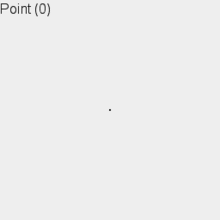
The construction ofhypercubescan be imagined the following way:
- 1-dimensional:Two points A and B can be connected to become a line, giving a new line segment AB.
- 2-dimensional:Two parallel line segments AB and CD separated by a distance of AB can be connected to become a square, with the corners marked as ABCD.
- 3-dimensional:Two parallel squares ABCD and EFGH separated by a distance of AB can be connected to become a cube, with the corners marked as ABCDEFGH.
- 4-dimensional:Two parallel cubes ABCDEFGH and IJKLMNOP separated by a distance of AB can be connected to become a tesseract, with the corners marked as ABCDEFGHIJKLMNOP. However, this parallel positioning of two cubes such that their 8 corresponding pairs of vertices are each separated by a distance of AB can only be achieved in a space of 4 or more dimensions.
The 8 cells of the tesseract may be regarded (three different ways) as two interlocked rings of four cubes.[6]
The tesseract can be decomposed into smaller 4-polytopes. It is the convex hull of the compound of twodemitesseracts(16-cells). It can also betriangulatedinto 4-dimensionalsimplices(irregular 5-cells) that share their vertices with the tesseract. It is known that there are92487256such triangulations[7]and that the fewest 4-dimensional simplices in any of them is 16.[8]
The dissection of the tesseract into instances of itscharacteristic simplex(a particularorthoschemewith Coxeter diagram![]()
![]()
![]()
![]()
![]()
![]()
![]() ) is the most basic direct construction of the tesseract possible. Thecharacteristic 5-cell of the 4-cubeis afundamental regionof the tesseract's definingsymmetry group,the group which generates theB4polytopes.The tesseract's characteristic simplex directlygeneratesthe tesseract through the actions of the group, by reflecting itself in its own bounding facets (itsmirror walls).
) is the most basic direct construction of the tesseract possible. Thecharacteristic 5-cell of the 4-cubeis afundamental regionof the tesseract's definingsymmetry group,the group which generates theB4polytopes.The tesseract's characteristic simplex directlygeneratesthe tesseract through the actions of the group, by reflecting itself in its own bounding facets (itsmirror walls).
Radial equilateral symmetry
[edit]The radius of ahyperspherecircumscribed about a regular polytope is the distance from the polytope's center to one of the vertices, and for the tesseract this radius is equal to its edge length; the diameter of the sphere, the length of the diagonal between opposite vertices of the tesseract, is twice the edge length. Only a few uniformpolytopeshave this property, including the four-dimensional tesseract and24-cell,the three-dimensionalcuboctahedron,and the two-dimensionalhexagon.In particular, the tesseract is the only hypercube (other than a zero-dimensional point) that isradially equilateral.The longest vertex-to-vertex diagonal of an-dimensional hypercube of unit edge length iswhich for the square isfor the cube isand only for the tesseract isedge lengths.
An axis-aligned tesseract inscribed in a unit-radius 3-sphere has vertices with coordinates
Properties
[edit]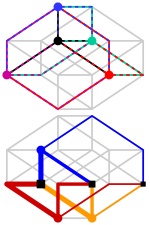
For a tesseract with side lengths:
- Hypervolume(4D):
- Surface "volume" (3D):
- Face diagonal:
- Cell diagonal:
- 4-space diagonal:
As a configuration
[edit]Thisconfiguration matrixrepresents the tesseract. The rows and columns correspond to vertices, edges, faces, and cells. The diagonal numbers say how many of each element occur in the whole tesseract. The nondiagonal numbers say how many of the column's element occur in or at the row's element.[9]For example, the 2 in the first column of the second row indicates that there are 2 vertices in (i.e., at the extremes of) each edge; the 4 in the second column of the first row indicates that 4 edges meet at each vertex.
Projections
[edit]It is possible to project tesseracts into three- and two-dimensional spaces, similarly to projecting a cube into two-dimensional space.


Thecell-firstparallelprojectionof the tesseract into three-dimensional space has acubicalenvelope. The nearest and farthest cells are projected onto the cube, and the remaining six cells are projected onto the six square faces of the cube.
Theface-firstparallel projection of the tesseract into three-dimensional space has acuboidalenvelope. Two pairs of cells project to the upper and lower halves of this envelope, and the four remaining cells project to the side faces.
Theedge-firstparallel projection of the tesseract into three-dimensional space has an envelope in the shape of ahexagonal prism.Six cells project onto rhombic prisms, which are laid out in the hexagonal prism in a way analogous to how the faces of the 3D cube project onto six rhombs in a hexagonal envelope under vertex-first projection. The two remaining cells project onto the prism bases.
Thevertex-firstparallel projection of the tesseract into three-dimensional space has arhombic dodecahedralenvelope. Two vertices of the tesseract are projected to the origin. There are exactly two ways ofdissectinga rhombic dodecahedron into four congruentrhombohedra,giving a total of eight possible rhombohedra, each a projectedcubeof the tesseract. This projection is also the one with maximal volume. One set of projection vectors areu= (1,1,−1,−1),v= (−1,1,−1,1),w= (1,−1,−1,1).
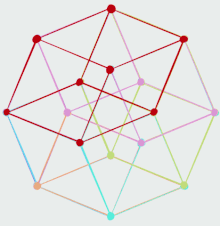
| Coxeter plane | B4 | B4--> A3 | A3 |
|---|---|---|---|
| Graph | 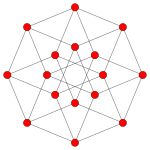
|

|
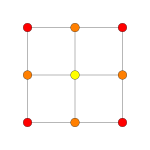
|
| Dihedral symmetry | [8] | [4] | [4] |
| Coxeter plane | Other | B3/ D4/ A2 | B2/ D3 |
| Graph | 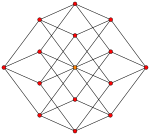
|
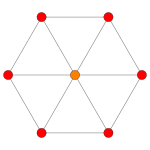
|

|
| Dihedral symmetry | [2] | [6] | [4] |
 A 3D projection of a tesseract performing asimple rotationabout a plane in 4-dimensional space. The plane bisects the figure from front-left to back-right and top to bottom. |
 A 3D projection of a tesseract performing adouble rotationabout two orthogonal planes in 4-dimensional space. |
 Perspective withhidden volume elimination.The red corner is the nearest in4Dand has 4 cubical cells meeting around it. |
 Thetetrahedronforms theconvex hullof the tesseract's vertex-centered central projection. Four of 8 cubic cells are shown. The 16th vertex is projected toinfinityand the four edges to it are not shown. |
 Stereographic projection (Edges are projected onto the3-sphere) |
 Stereoscopic3D projection of a tesseract (parallel view) |
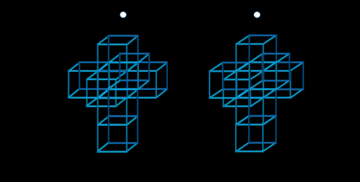 Stereoscopic3D DisarmedHypercube |
Tessellation
[edit]The tesseract, like allhypercubes,tessellatesEuclidean space.The self-dualtesseractic honeycombconsisting of 4 tesseracts around each face hasSchläflisymbol{4,3,3,4}.Hence, the tesseract has adihedral angleof 90°.[10]
The tesseract'sradial equilateral symmetrymakes its tessellation theunique regular body-centered cubic latticeof equal-sized spheres, in any number of dimensions.
Related polytopes and honeycombs
[edit]The tesseract is 4th in a series ofhypercube:

|

|

|

|

|

|

|

|
| Line segment | Square | Cube | 4-cube | 5-cube | 6-cube | 7-cube | 8-cube |
The tesseract (8-cell) is the third in the sequence of 6 convex regular 4-polytopes (in order of size and complexity).
| Regular convex 4-polytopes | |||||||
|---|---|---|---|---|---|---|---|
| Symmetry group | A4 | B4 | F4 | H4 | |||
| Name | 5-cell Hyper-tetrahedron |
16-cell Hyper-octahedron |
8-cell Hyper-cube |
24-cell
|
600-cell Hyper-icosahedron |
120-cell Hyper-dodecahedron | |
| Schläfli symbol | {3, 3, 3} | {3, 3, 4} | {4, 3, 3} | {3, 4, 3} | {3, 3, 5} | {5, 3, 3} | |
| Coxeter mirrors | |||||||
| Mirror dihedrals | 𝝅/3𝝅/3𝝅/3𝝅/2𝝅/2𝝅/2 | 𝝅/3𝝅/3𝝅/4𝝅/2𝝅/2𝝅/2 | 𝝅/4𝝅/3𝝅/3𝝅/2𝝅/2𝝅/2 | 𝝅/3𝝅/4𝝅/3𝝅/2𝝅/2𝝅/2 | 𝝅/3𝝅/3𝝅/5𝝅/2𝝅/2𝝅/2 | 𝝅/5𝝅/3𝝅/3𝝅/2𝝅/2𝝅/2 | |
| Graph | 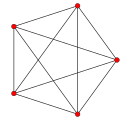
|
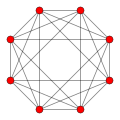
|

|
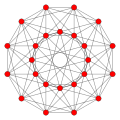
|

|

| |
| Vertices | 5 tetrahedral | 8 octahedral | 16 tetrahedral | 24 cubical | 120 icosahedral | 600 tetrahedral | |
| Edges | 10 triangular | 24 square | 32 triangular | 96 triangular | 720 pentagonal | 1200 triangular | |
| Faces | 10 triangles | 32 triangles | 24 squares | 96 triangles | 1200 triangles | 720 pentagons | |
| Cells | 5 tetrahedra | 16 tetrahedra | 8 cubes | 24 octahedra | 600 tetrahedra | 120 dodecahedra | |
| Tori | 15-tetrahedron | 28-tetrahedron | 24-cube | 46-octahedron | 2030-tetrahedron | 1210-dodecahedron | |
| Inscribed | 120 in 120-cell | 675 in 120-cell | 2 16-cells | 3 8-cells | 25 24-cells | 10 600-cells | |
| Great polygons | 2squaresx 3 | 4 rectangles x 4 | 4hexagonsx 4 | 12decagonsx 6 | 100irregular hexagonsx 4 | ||
| Petrie polygons | 1pentagonx 2 | 1octagonx 3 | 2octagonsx 4 | 2dodecagonsx 4 | 430-gonsx 6 | 2030-gonsx 4 | |
| Long radius | |||||||
| Edge length | |||||||
| Short radius | |||||||
| Area | |||||||
| Volume | |||||||
| 4-Content | |||||||
As a uniformduoprism,the tesseract exists in asequence of uniform duoprisms:{p}×{4}.
The regular tesseract, along with the16-cell,exists in a set of 15uniform 4-polytopes with the same symmetry.The tesseract {4,3,3} exists in asequence of regular 4-polytopes and honeycombs,{p,3,3} withtetrahedralvertex figures,{3,3}. The tesseract is also in asequence of regular 4-polytope and honeycombs,{4,3,p} withcubiccells.
| Orthogonal | Perspective |
|---|---|

|

|
| 4{4}2,with 16 vertices and 8 4-edges, with the 8 4-edges shown here as 4 red and 4 blue squares | |
Theregular complex polytope4{4}2,![]()
![]()
![]() ,inhas a real representation as a tesseract or 4-4duoprismin 4-dimensional space.4{4}2has 16 vertices, and 8 4-edges. Its symmetry is4[4]2,order 32. It also has a lower symmetry construction,
,inhas a real representation as a tesseract or 4-4duoprismin 4-dimensional space.4{4}2has 16 vertices, and 8 4-edges. Its symmetry is4[4]2,order 32. It also has a lower symmetry construction,![]()
![]()
![]() ,or4{}×4{}, with symmetry4[2]4,order 16. This is the symmetry if the red and blue 4-edges are considered distinct.[11]
,or4{}×4{}, with symmetry4[2]4,order 16. This is the symmetry if the red and blue 4-edges are considered distinct.[11]
In popular culture
[edit]Since their discovery, four-dimensional hypercubes have been a popular theme in art, architecture, and science fiction. Notable examples include:
- "And He Built a Crooked House",Robert Heinlein's 1940 science fiction story featuring a building in the form of a four-dimensional hypercube.[12]This andMartin Gardner's "The No-Sided Professor", published in 1946, are among the first in science fiction to introduce readers to theMoebius band,theKlein bottle,and the hypercube (tesseract).
- Crucifixion (Corpus Hypercubus),a 1954 oil painting by Salvador Dalí featuring a four-dimensional hypercube unfolded into a three-dimensionalLatin cross.[13]
- TheGrande Arche,a monument and building near Paris, France, completed in 1989. According to the monument's engineer,Erik Reitzel,the Grande Arche was designed to resemble the projection of a hypercube.[14]
- Fez,a video game where one plays a character who can see beyond the two dimensions other characters can see, and must use this ability to solve platforming puzzles. Features "Dot", a tesseract who helps the player navigate the world and tells how to use abilities, fitting the theme of seeing beyond human perception of known dimensional space.[15]
The wordtesseracthas been adopted for numerous other uses in popular culture, including as a plot device in works of science fiction, often with little or no connection to the four-dimensional hypercube; seeTesseract (disambiguation).
See also
[edit]Notes
[edit]- ^"The Tesseract - a 4-dimensional cube".www.cut-the-knot.org.Retrieved2020-11-09.
- ^Elte, E. L.(1912).The Semiregular Polytopes of the Hyperspaces.Groningen: University of Groningen.ISBN1-4181-7968-X.
- ^Coxeter 1973,pp. 122–123, §7.2. illustration Fig 7.2C.
- ^ "tesseract".Oxford English Dictionary(Online ed.).Oxford University Press.199669.(Subscription orparticipating institution membershiprequired.)
- ^"Unfolding an 8-cell".Unfolding.apperceptual.com.Retrieved21 January2018.
- ^Coxeter 1970,p. 18.
- ^Pournin, Lionel (2013), "The flip-Graph of the 4-dimensional cube is connected",Discrete & Computational Geometry,49(3): 511–530,arXiv:1201.6543,doi:10.1007/s00454-013-9488-y,MR3038527,S2CID30946324
- ^Cottle, Richard W. (1982), "Minimal triangulation of the 4-cube",Discrete Mathematics,40:25–29,doi:10.1016/0012-365X(82)90185-6,MR0676709
- ^Coxeter 1973,p. 12, §1.8 Configurations.
- ^Coxeter 1973,p. 293.
- ^Coxeter, H. S. M.,Regular Complex Polytopes,second edition, Cambridge University Press, (1991).
- ^Fowler, David (2010), "Mathematics in Science Fiction: Mathematics as Science Fiction",World Literature Today,84(3): 48–52,doi:10.1353/wlt.2010.0188,JSTOR27871086,S2CID115769478
- ^Kemp, Martin (1 January 1998), "Dali's dimensions",Nature,391(27): 27,Bibcode:1998Natur.391...27K,doi:10.1038/34063,S2CID5317132
- ^Ursyn, Anna (2016),"Knowledge Visualization and Visual Literacy in Science Education",Knowledge Visualization and Visual Literacy in Science Education,Information Science Reference, p. 91,ISBN9781522504818
- ^"Dot (Character) - Giant Bomb".Giant Bomb.Retrieved21 January2018.
References
[edit]- Coxeter, H.S.M.(1973).Regular Polytopes(3rd ed.). New York: Dover. pp.122–123.
- F. Arthur Sherk, Peter McMullen, Anthony C. Thompson, Asia Ivic Weiss (1995)Kaleidoscopes: Selected Writings of H.S.M. Coxeter,Wiley-Interscience PublicationISBN978-0-471-01003-6[1]
- (Paper 22) H.S.M. Coxeter,Regular and Semi Regular Polytopes I,Mathematische Zeitschrift46 (1940) 380–407, MR 2,10]
- (Paper 23) H.S.M. Coxeter,Regular and Semi-Regular Polytopes II,[Math. Zeit. 188 (1985) 559-591]
- (Paper 24) H.S.M. Coxeter,Regular and Semi-Regular Polytopes III,[Math. Zeit. 200 (1988) 3-45]
- Coxeter, H.S.M.(1970), "Twisted Honeycombs",Conference Board of the Mathematical Sciences Regional Conference Series in Mathematics,4,Providence, Rhode Island: American Mathematical Society
- John H. Conway,Heidi Burgiel, Chaim Goodman-Strauss (2008)The Symmetries of Things,ISBN978-1-56881-220-5(Chapter 26. pp. 409: Hemicubes: 1n1)
- T. Gosset(1900)On the Regular and Semi-Regular Figures in Space of n Dimensions,Messenger of Mathematics,Macmillan.
- Hall, T. Proctor(1893). "The projection of fourfold figures on a three-flat".American Journal of Mathematics.15:179–189.JSTOR2369565.
- Norman JohnsonUniform Polytopes,Manuscript (1991)
- N.W. Johnson:The Theory of Uniform Polytopes and Honeycombs,Ph.D. (1966)
- Victor Schlegel(1886)Ueber Projectionsmodelle der regelmässigen vier-dimensionalen Körper,Waren.
External links
[edit]- Klitzing, Richard."4D uniform polytopes (polychora) x4o3o3o - tes".
- ken perlin's home pageA way to visualize hypercubes, byKen Perlin
- Some Notes on the Fourth Dimensionincludes animated tutorials on several different aspects of the tesseract, byDavide P. Cervone
- Tesseract animation with hidden volume elimination


![{\displaystyle {\bigl [}{-{\tfrac {1}{2}}},{\tfrac {1}{2}}{\bigr ]}}](https://wikimedia.org/api/rest_v1/media/math/render/svg/937dd70d7cd719d027e8e6f4d6f468ebe6e9dcb1)
